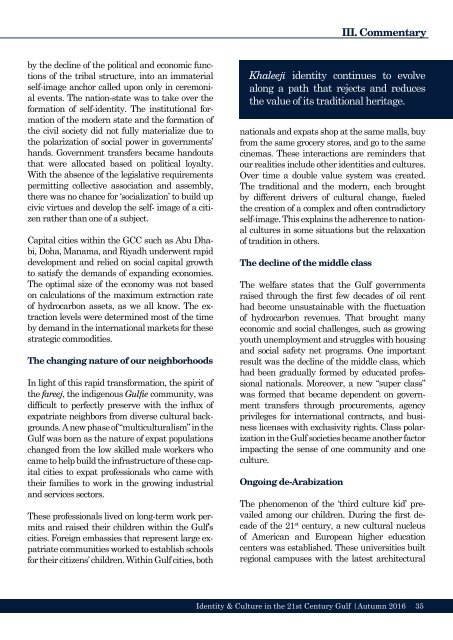Create successful ePaper yourself
Turn your PDF publications into a flip-book with our unique Google optimized e-Paper software.
III. Commentary<br />
by the decline of the political and economic functions<br />
of the tribal structure, into an immaterial<br />
self-image anchor called upon only in ceremonial<br />
events. The nation-state was to take over the<br />
formation of self-identity. The institutional formation<br />
of the modern state and the formation of<br />
the civil society did not fully materialize due to<br />
the polarization of social power in governments’<br />
hands. Government transfers became handouts<br />
that were allocated based on political loyalty.<br />
With the absence of the legislative requirements<br />
permitting collective association and assembly,<br />
there was no chance for ‘socialization’ to build up<br />
civic virtues and develop the self- image of a citizen<br />
rather than one of a subject.<br />
Capital cities within the GCC such as Abu Dhabi,<br />
Doha, Manama, and Riyadh underwent rapid<br />
development and relied on social capital growth<br />
to satisfy the demands of expanding economies.<br />
The optimal size of the economy was not based<br />
on calculations of the maximum extraction rate<br />
of hydrocarbon assets, as we all know. The extraction<br />
levels were determined most of the time<br />
by demand in the international markets for these<br />
strategic commodities.<br />
The changing nature of our neighborhoods<br />
In light of this rapid transformation, the spirit of<br />
the fareej, the indigenous Gulfie community, was<br />
difficult to perfectly preserve with the influx of<br />
expatriate neighbors from diverse cultural backgrounds.<br />
A new phase of “multiculturalism” in the<br />
Gulf was born as the nature of expat populations<br />
changed from the low skilled male workers who<br />
came to help build the infrastructure of these capital<br />
cities to expat professionals who came with<br />
their families to work in the growing industrial<br />
and services sectors.<br />
These professionals lived on long-term work permits<br />
and raised their children within the Gulf’s<br />
cities. Foreign embassies that represent large expatriate<br />
communities worked to establish schools<br />
for their citizens’ children. Within Gulf cities, both<br />
Khaleeji identity continues to evolve<br />
along a path that rejects and reduces<br />
the value of its traditional heritage.<br />
nationals and expats shop at the same malls, buy<br />
from the same grocery stores, and go to the same<br />
cinemas. These interactions are reminders that<br />
our realities include other identities and cultures.<br />
Over time a double value system was created.<br />
The traditional and the modern, each brought<br />
by different drivers of cultural change, fueled<br />
the creation of a complex and often contradictory<br />
self-image. This explains the adherence to national<br />
cultures in some situations but the relaxation<br />
of tradition in others.<br />
The decline of the middle class<br />
The welfare states that the Gulf governments<br />
raised through the first few decades of oil rent<br />
had become unsustainable with the fluctuation<br />
of hydrocarbon revenues. That brought many<br />
economic and social challenges, such as growing<br />
youth unemployment and struggles with housing<br />
and social safety net programs. One important<br />
result was the decline of the middle class, which<br />
had been gradually formed by educated professional<br />
nationals. Moreover, a new “super class”<br />
was formed that became dependent on government<br />
transfers through procurements, agency<br />
privileges for international contracts, and business<br />
licenses with exclusivity rights. Class polarization<br />
in the Gulf societies became another factor<br />
impacting the sense of one community and one<br />
culture.<br />
Ongoing de-Arabization<br />
The phenomenon of the ‘third culture kid’ prevailed<br />
among our children. During the first decade<br />
of the 21 st century, a new cultural nucleus<br />
of American and European higher education<br />
centers was established. These universities built<br />
regional campuses with the latest architectural<br />
<strong>Identity</strong> & <strong>Culture</strong> in the 21st Century Gulf |Autumn 2016 35


